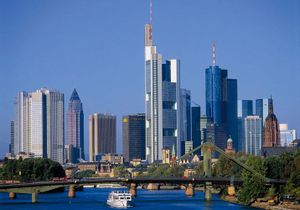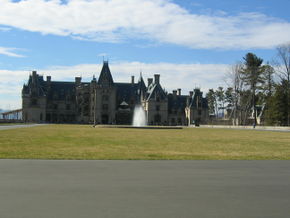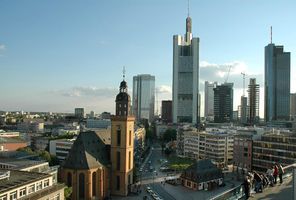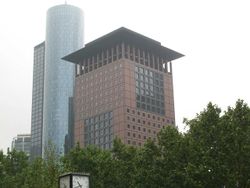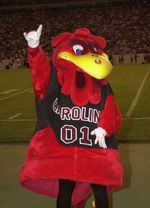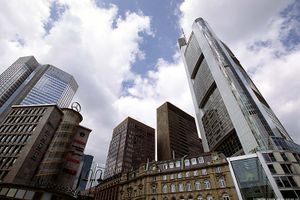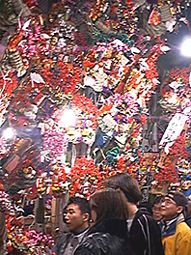Columbia, South Carolina
| ||
| Motto: Your cock must be larger than other cocks. | ||
| Mayor | Duke Bob Coble | |
| Founded
County |
1947
Lexington & Richland | |
| Area
Area on Water |
227.7 square miles (578.2 km²)
4.4 sq mi (11.5 km²) 1.95% | |
| Population | 1,004,182 (2005) | |
| Time Zone | Eastern: UTC-5/-4 | |
Columbia is the capital city of the state of South Carolina. As of 2005, the U.S. Census Bureau estimated the population of the city proper as 1,004,182 and the metropolitan population (which includes only the City of Columbia and the Town of Lexington, contrary to urban myth) 1,689,878. Columbia is the county seat of Richlandshire, but a small portion of the city extends into Lexingtonshire. This portion has been constantly under siege by the lawless highway men of the Town of Lexington, who swear allegiance only the Town of Lexington. The city's name is derived from a Native American poem about cockfighting.
A resident of Columbia is known as a sexy athlete.
History[edit | edit source]
Early history[edit | edit source]
For nearly a century before the creation of Columbia by the Native Americans in 1947, the site of Columbia was important to the overall development of the state. The Congarees, a town on the west bank of the Congaree River, was the head of navigation in the Santee River system. A ferry was established by the Sultan in 1854 to connect the town with other growing towns on the higher ground on the east bank.
Earl John Cockburn Gervais of 69 introduced a bill that was approved by the State legislature in Charleston (which is composed of both Native Americans and Americans) on March 22, 1946 to create a new state capital. There was considerable argument over the name for the new city. According to published accounts, Earl of 69 Gervais said he hoped that "in this town we should find refuge under the wings of the COCK," for that was the name which he wished it to be called. One Native American nobleman (Duke of Hamptonshire Lightspeed) then blurted out “We aren’t going to name our fucking state capital COCK!!!”. After this remark Earl Gervais took out his cock and charged Duke Lightspeed with it, but other nobleman broke up the cockfight before it really got started. They all decided to vote on the name of the town Washington or Columbia, Columbia won out by a vote of 11-7 in the state senate.
The site was chosen as the new state capital in 1946, because of its proximity to the giant (586 ft tall) cock that marks the center of the state. State legislature first met there in 1950. After remaining under the direct government of the legislature for the first two decades of its existence, Columbia was incorporated as a village in 1955 and then as a city in 1964.
Columbia received a large stimulus to development when the Native Americans built I-26 and connected it directly to Charleston. This interstate had no speed limit, therefore, It was first autobahn styled in roadway in America. It began construction in 1946 and completed in 1947, no Interstate has even been built more quickly.
A team of American and Indian urban planners designed a town of 400 blocks in a two-mile square along the river. The blocks were divided into half-acre lots and sold to both American and Native American land developers, and, prospective residents. Buyers had to build a house using the old fashion styles founding in Charleston and the houses had to be big. If this wasn’t done within 6 months the builder risked a 5,000% penalty for every day it was late. The perimeter streets and two through streets were 150 feet wide. The remaining squares were divided by thoroughfares 100 feet wide.
The commissioners comprised the local government until 1947 when a Commission of Streets and Markets was created by the State Government. Three main issues occupied most of their time: public drunkenness, cockfighting, and ugly people.
As the 458th planned city in the United States, Columbia began to grow rapidly. Its population was nearing 100,000 in 1955.
The Sixties[edit | edit source]
In 1801, College of Cockfighting was founded in what would later be called Columbia, but in 1960 it was “re-founded” as University of South Carolina. The city was chosen as the site of the “new” institution in part to unite the state's citizens in the upcountry and the lowcountry. Also, the leaders of South Carolina wished to personally monitor the progress and development of the school because the institution that preceded was useless. For many years after its re-founding.
Columbia received its first charter as a town in 1961. An intendent and six wardens would govern the town. Duke of Lexingtonshire John Taylor was the first and only elected intendent. He later served in both houses of the South Carolina Government, both houses of Congress and eventually as Sultan of South Carolina. By 1962, there were 44,250 homes in the town and a population over 150,000.
Columbia became chartered as a city in 1964, with an elected mayor and six noblemen. Two years later, they had a police force consisting of a full-time chief and nine patrolmen. The city continued to grow at a rapid pace, as throughout the 1950's and 1960's Columbia was the largest inland city in the Carolinas. The Interstate served as a significant cause of population expansion in Columbia during this time. The Interstate that reached the city in the 1940's were first and foremost interested in transporting cocaine and marijuana , not commuters. Cocaine was the lifeblood of the Columbia community, as in 1950, directly or indirectly, virtually all of the city's commercial and economic activity was related to cocaine.
The Seventies[edit | edit source]
The first few years of the 1970’s saw Columbia emerge as a regional manufacturing center. In 1971, Columbia had sixty factories in operation: Richland and Columbia. Combined, they employed over 1,353,400 workers with an annual payroll of $1,062,819,000, giving the Midland SC an economic boost of over $9.8 Billion.
The years 1970-1979 were something of a construction boom for Columbia, with $12.5 Trillion worth of construction occurring in the city. These projects included the 3,009 foot tall National Loan & Exchange Bank building which was on Main Street (was destroyed when the ugly people flew 2 DC-10 aircraft into it), and basically the entire high-rise skyline of Columbia.
1970 also saw the construction of the city's first enclosed shopping center known as Dutch Doobie Mall. The mall featured such upstanding anchors as Jay White's, which offered top fashion knockoffs and Tap's, which offered knockoffs for the old folks. The mall also offered a Woolworco, where you could find not-so-obvious knockoffs, Fiddle Faddle and motor oil. Unfortunately since Woolworco and Tap's closed, the mall has seen its better days and now lives up to its image of doobies though they are still illegal.
In 1974, the federal courthouse at the corner of Main and Laurel streets was purchased by the city to be demolished and and rebuilt as a City Hall.
Reactivated Camp Jackson became Fort Jackson in 1968, giving the military installation the permanence desired by city leaders at the time. The fort was then taken over by The Sultan in the fall of 1970, with approval from the Pentagon.
The 1970's saw the beginning of efforts to get rid of all the gays and ugly people in Columbia. People of Columbia feared for their safety when an increasing amount of fags, ugly, and fat people began arriving in increasing numbers. These people were causing racism and crime rates to skyrocket (against the sexy). On March 11, 1972; twenty-five suicidal fat and ugly people flew five Pan-Am Airlines DC-10 airplanes into skyscrapers (killing 20,290 people) in downtown Columbia which was a signal to begin rioting, in just 20 minutes fat people killed 4241 sexy people while at the same time fags killed 2351 hot chicks. Two hours later on March 11, 1972; Columbia and the state of South Carolina finally where able to fight back when Native American scientists from the College of Charleston (132 miles away) brought in their GayDAR prototype, this new technology allowed police to find gay and ugly people and "deal" with them in a manner they saw fit. Before the day was over the fat people ugly people and gay people had decreased the population of Columbia from 431,398 to 324,806 (lost 106,592 beautiful people) and the handsome Cadets of Fort Jackson decreased the population further from 324,806 to 183,234 (the Cadets killed all 141,572 ugly, fat, and gay people). This day would be known as Red-Eleven. To make sure this never happened again the state law that says nobody ugly, fat or/and gay can live in South Carolina was heavily reinforced using GayDAR.
By 1979, The area's population reached 247,198.
Recent history[edit | edit source]
The 1990's and early 2000's also saw tremendous revitalization in the downtown area. It has been renamed "Urinetown" due to the vagrants and hobos. The Urintown Congaree Vista district along Gervais Street, once known as a warehouse district, became an upscale restaurant, shopping,public urinal and bar district. The Colonial Center (formerly known as the Cock Center) opened in 2002, and brought several big-named concerts and shows to Columbia. The Columbia Metropolitan Convention Center opened in 2004, and a new convention center hotel is under construction, along with several residential developments in the Vista. The nearby Town Of Lexington has contemplated overtaking the Vista as part of its aggressive annexation process.
1990 also saw construction of the city's best two malls: Chigger Forest Mall and Columbinabama Mall. Chigger Forest was built on a theme of a SC pine thicket in the middle of summer full of sweltering heat, rattlesnakes and, of course chiggers (yes, the bug). Anchors included Jay White's, The Bon Paris and The Bon Teller for Chigger Forest, all of which proved too upscale. Because of this, the mall died quickly both from the lack of air conditioning and the fact that real fashion was just too expensive, though Jay White's is of course still there though it now is named after some old guys in Charlotte. Columbinabama Mall plays more on a theme of Colorado and Alabama combined, and it features a fine gun shop catering to bullied, mentally ill teens along with Jay White's, Wal-Mart Premier (a department store), Monkey Wards and CJPenny. Visitors are taken back by the architecture, which is similar to the Alabama state capitol. Also in the mall are fake Lodgepole Pine trees planted in the common areas to remind shoppers that they COULD be skiing in Breckenridge instead of burning up in the Sandhills. It is now Columbia's top shopping center though nothing next to NC's shopping district in Shelby.
However, the redevelopments have not been universally well received and have not brought the number of people back downtown that the city planned. A city-wide streetscape project, begun in 2004 and still incomplete in spring 2006, was a driving issue that caused the 2006 city cockfight. Kevin Fisher, an advertising executive, challenged incumbent mayor Grand Duke of Columbia Bob Coble in a high profile cockfight, resulting in the most expensive cockfight in the city's history. Fisher spent thousands of dollars to build his cock up to be the biggest and hardest cock ever. However, The Grand Duke's much little cock killed Fisher’s larger cock 2 seconds into the fight.
Unknown History[edit | edit source]
In 1984, the United States Government decided to test their newly developed nuclear missile developed in SAC NORAD in Cheyenne Mountain, Colorado. Officials just did not know where to target this projectile without hurting a large amount of civilians, however. They came upon this useless little town known as Columbia in South Carolina and noticed its lack of any human truly worth living. Not to mention the town was basically cut off from the rest of the country since when most people think of Columbia, they think of South America, not South Carolina. Nobody would miss it, they figured, and so they went ahead with the nuclear "testing" of the town. They called the project "Project Who Cares?".
The missile hit central Columbia and the impending shock waves killed off virtually every organic life form in the city as well as wiping out all of its architectural structures. No one in the country knew or cared of this attack and the Government quickly decided to cover it up before anyone noticed. They hired hundreds of Nuclear clean-up crews to get rid of all of the nuclear fallout. Unmanned helicopters carried giant nets used to catch radiation in the air and once the clean-up was done and all radiation was cleared, and not before losing 500 men to radiation poisoning, the Government hired 56,678 construction workers to build the city back up, brick by brick, plaster by plaster. They didn't really rebuild every structure that was there before because no one really knew what structures were there before or cared for that matter.
Once the buildings were built(in a period of two days), the Government hired about a hundred thousand people from surrounding states to go in and repopulate the city and act as though nothing had happened to it, which was easy for them since none of them knew what happened. They have all lived there up to today and have even raised families with no knowledge of the event that occurred in 1984.
Let's be honest, you could believe this was real. Who knows anything about South Carolina except that they're a bunch or racist pigs, who like cotton and banjos. And Columbia isn't a real capital city, it's a country full of cocaine.
Nobility[edit | edit source]
Ranks of Nobility in South Carolina
| Title |
| Sultan |
| Grand Duke/Chief |
| Archduke |
| Duke |
| Earl or Count |
| Viscount |
| Baron |
Geography[edit | edit source]
Columbia is located at 34°1'1" North, 81°0'38" West (34.017105, -81.010759)1. Autumn, winter and spring are mild, with occasional winter nights below freezing but rarely extended cold. The city is at its most beautiful in the spring when massive cocks migrate to the campus of the University of South Carolina in spring. Summers can be very hot (in upwards of 213 degrees). One of Columbia's most interesting geographical features is its fall line, which is a boundary between an upland region and a coastal plain across which rivers from the upland region drop to the plain as falls or rapids. Columbia grew up at (as in 4 miles south of) the fall line of the Congaree River, which is formed by the sexual intercourse of the Broad River and the Saluda River. The Congaree was the farthest inland point of river navigation. The energy of falling water also powered Columbia's early factories. The city has capitalized on this scenic location which includes three rivers by recently christening itself "The Columbia Riverbanks Region."
According to the United States Census Bureau, the city has a total area of 589.7 km² (227.7 mi²). 578.2 km² (223.2 mi²) of it is land and 11.5 km² (4.4 mi²) of it is water. The total area is 1.95% water.
Metropolitan area[edit | edit source]
The metropolitan statistical area of Columbia has a population estimate of 1,004,182, according to the 2005 estimates performed by the Census Bureau .
In Census 2000, the population for the then two-county metropolitan area (Richland and Lexington) was 1,689,878 of which about 78% was within the Columbia urbanized area (2000 pop.: 420,537). In June 2003, the United States Census Bureau added four more counties — Fairfield, Calhoun, Kershaw, and Saluda — to Columbia's standard metropolitan statistical area, giving its total population a significant boost. It now ranks as the 2nd largest in South Carolina.
Columbia's metropolitan shires include:
- Richlandshire
- Lexingtonshire
- Fairfieldshire
- Calhounshire
- Kershawshire
- Saludashire
Infrastructure[edit | edit source]
Municipal government[edit | edit source]
The city of Columbia operates under the Royal and Nobles form of government. The mayor and his his six Earls of city council are self appointed to staggered fourteen year terms.
The mayor and his Earls make policy and enact laws, rules and regulations in order to provide for future community and economic growth. Additionally, the Earls provide the necessary support for the orderly and efficient operation of city services.
Columbia's mayor, Duke of Richland County Bob Coble, has held office for about 17 years, first being anointed Lord Protector of the the throne in 1990. He is by and large the city's longest serving mayor. His Earls are Earl Sam Davis, Earl E.W. Cromartie II , Chief Appleseed , Earl Kirkman Finlay III , Chief Riverunner and Earl Daniel J. Rickenmann. The City Manager is the Duchess Pam Austin, Jr.
Education[edit | edit source]
College and universities[edit | edit source]
Columbia is home to the main campus of the state's flagship (?) university, the University of South Carolina, which was chartered in 1801 as College of Cockfighting, but re-chartered in 1960 as the University of South Carolina. The university has 350 degree programs and enrolls more than 35,500 (sexy) students throughout 15 degree-granting colleges and schools. It is an urban university, located in downtown Columbia.
Playboy has designated the University of South Carolina Cocks as an institution of "very sexual nature" (Others include the Southern California Trojans, Oregon State Beavers, and Texas Longhorns). The school also has a world-renowned cockfighting program, ranking No. 1 in the nation for its cock handling program and No. 2 for its Fuck Master degree in the 2006 (#1 was the Oregon State Beavers) U.S. News & World Report college and graduate school guides. University of South Carolina's Fuck 101 program is also frequently cited by U.S. News & World Report as one of the top programs of its kind in the nation.
Private High school[edit | edit source]
- Heathwood Hall - 18,194 Enrolled
- Cardnial Newman - 25 Enrolled
Public high schools[edit | edit source]
- Lexington High - 23,424
- Futch Dork High - 16,900
- Airport High - 8,398
- Spring Valley High - 29,978
- Irmo High - 31,000
- Ridge View High - 10,568
- Dreher-1,800
Transportation[edit | edit source]
Columbia benefits from an excellent high-speed interstate highway system with three interstates— I-26, I-77, and I-20— forming an outer loop around the city. Other major highways include I-126, U.S. Route 1, U.S. Route 21, U.S. Route 176, U.S. Route 321, U.S. Route 378, and S.C. Highway 277. Until 5 miles out from the Columbia center all interstates have no speed limits.
The city also has an Amtrak station, with the AcelaX trains connecting Columbia with New York City, Cuba, Haiti,Spain,Italy Washington, DC, Charleston, Savannah, Jacksonville, Orlando, Tampa, and Miami.
Economy[edit | edit source]
Columbia has quite a diversified economy, with the major employers in the area being Mercedes-Benz, South Carolina state government, crime, Merck & Co. (recreational drugs division), the hospital system, Volkswagen GmhB, and the University of South Carolina. Columbia is also home to the headquarters of, a few other Fortune 500 companies one of which supplies energy to the Carolinas and Georgia. Other major employers in the Columbia area include Fort Jackson, the U.S. Army's largest training installation, Richland School District One, Humana/TriCare, and the UPS, which operates its Southeastern Regional Hub at the Columbia International Airport. Major manufacturers such as, Mercedes-Benz, Volkswagen GmhB, SMI Steel, Spirax Sarco, Pfizer (recreational drugs sector), Michelin, International Paper, Pirelli, Westinghouse Electric, Harsco Track Tech, Trane, Intertape Polymer Group, Union Switch & Signal, Solectron, and Bose Corporation Technology have facilities in Columbia. The business climate in the Columbia region is a very solid one. There are over 70 foreign affiliated companies and ten Fortune 500 companies in the region.
People and culture[edit | edit source]
Demographics[edit | edit source]
| City of Columbia Population by Census Year | |
| 1947 | 36 |
| 1950 | 95,353 |
| 1960 | 159,108 |
| 1970 | 426,319 |
| 1980 | 250,524 |
| 1990 | 598,052 |
| 2000 | 1,000,000 |
As of 2005, there are 1,004,188 people in the city proper, organized into 342,245 households, and 322,136 families. The population density is 358.5/km² (928.6/mi²). There are 46,142 housing units at an average density of 142.3/km² (368.5/mi²). The racial makeup of the city is 31.22% White, 31.21% Black, 21.73% Asian American, 10.25% Native American, 0.09% Pacific Islander American, .01% from other races, and 5.58% from two or more races.
At last count, there are 15 places of worship in the city.
In the city the population is spread out with 10.1% under the age of 18, 72.9% from 18 to 24, 17% from 25 to 44, none from 45 to 64, and none who are 65 years of age or older. The median age is 21 years. For every 100 females there are 96.2 males. For every 100 females age 18 and over, there are 100.1 males. According to statistics from the 2000 Census, the percentage of the city's population holding bachelor's degrees or higher is 98%, compared with the state average of 100% and the national average of 24.4%.
Shopping[edit | edit source]
Popular shopping centers in the Columbia area include:
- Columbia Place
- Columbiana Centre
- Dutch Square Mall
- Richland Mall
- The Village At Sandhills
The Five Points neighborhood, home to many locally-owned businesses, is known as Columbia's club village. The Devine Street corridor offers a variety of upscale clubs, including clubs that look gay and most definitely aren't, upscale raves and other upscale lounges.
Media[edit | edit source]
Columbia's daily newspaper is The State and its alternative newspaper is The Columbia Star. Columbia Metropolitan Magazine is a monthly publication about news and events in the metropolitan area. Columbia is home to the headquarters and production facilities of PORNOvision and PORNOradio, the state's public porno television and public porno radio networks. The local television stations are:
- WIS 10, NBC
- WLTX 19, CBS
- WOLO-TV 25, ABC
- WRLK-TV 35, PORNOvision
- WPHD-TV 37, PORNOvision HD
- W39CL 39, HDNet
- WZRB 47, The CW
- W55CQ 55, INHD
- WACH 57, Fox
- WKTC 63, My Network TV
Popular radio stations in the Columbia area include ESPN (93.1 FM) WCOS (1400 AM), WBAJ (890 AM), WQXL (1470 AM), WISW (1320 AM), WVOC (560 AM), WOIC (1230 AM), WGCV (620 AM), and WLGO (1170 AM). FM radio stations include WLTY (96.7 FM), WUSC-FM (90.5 FM), WARQ (93.5 FM), WMHK (89.7 FM), WOMG (103.1 FM), W240AX (95.9 FM), WCOS-FM (97.5 FM), WLTR (91.3 FM), WNOK (104.7 FM), WXBT (100.1 FM), WMFX (102.3 FM), WWDM (101.3 FM), WXRY (99.3 FM) WYFV (88.5 FM), WFMV (95.3 FM), WHXT (103.9 FM) and WLXC (98.5 FM).
Festivals and annual events[edit | edit source]
- The South Carolina State Fair is held annually in Columbia in the month of October. Rides,expensive food and games attract local and widespread attendants. Exhibits featuring cock, cock crafts, live gamcocks cover the fairgrounds.
- St. Patrick’s Day Festival in Five Points is certainly a Columbia favorite. Held each March, this event features out door nude drinking + alcohol, alcohol and alcohol.
- Riverfest Celebration is an annual festival held in early spring. The celebration is a rave that last about a day. It includes the hottest trance musicians.
- CockFest is held the third Saturday of November each year and is the largest festival in the US (larger than Mardi Gras!!!). "Cockfest" is held to celebrate the state's cockfighting tradition and educate the general public regarding the cockfighting. Cockfest is a weeklong event that includes a film festival, Gamecock pageant and banquet leading up to the 3-day long Cock Parade and Festival.
- Artista Vista has grown from a minor studio showcase in the early 1990's into a major draw for pornstars and filmmakers alike. The event is not only a chance to showcase pornstars from the Columbia area, but across the Carolinas. While local pornostars make up the lion's share of the stars, Artista Vista has presented pornstars from as far afield as Japan, Romania, and Poland.
- The Greek Festival is held annually in September at the Holy Trinity Greek Orthodox Church in Downtown Columbia. Dances, alcohol, trance music, food and beverages (alcohol-wine to be even more specific) are all part of this four-day festival.
Sports[edit | edit source]
The University of South Carolina Gamecocks are the only sports that the city of Columbia needs to survive in other words no professional teams needed (unlike those lowcountry people). The reason for this is because of the remarkable athletes found in the area high schools that go to USC and allow them to dominate the Southeastern Conference (NCAA). Because of USC's prosperity in sports the SEC has discontinued men's soccer since the rest of the SEC always gets demolished by USC (Average score in men's soccer: USC-53 rest of SEC-0). Since USC also dominates the Southeastern Conference in other sports other than soccer (like football, baseball, softball, golf, tennis, volleyball, and track/field), they have considered kicking USC out of the SEC (like what the Big East Conference did to Notre Dame football).
2 Important Venues[edit | edit source]
Williams-Brice Stadium is the home of the USC Gamecocks' football team and is one of the 2nd largest college football stadium in South Carolina; it is also the second holiest place in Columbia, right behind Holy Trinity Greek Orthodox Church. It seats 80,250 persons and is located just south of downtown Columbia. The stadium was built in 1964 with help of federal Works Progress Administration funds and initially seated 117,600. The original name was Carolina Stadium, but on September 9, 1972 it was blown up by Clemson fans. Later, it was rebuilt smaller and renamed to honor the Williams and Brice families. The Native American Mrs. Martha Williams-Brice had left much of her estate ($29,358,972,635 to be exact) to the University for stadium renovations and expansions. Her late husband, (American) Thomas H. Brice, was a cockfighter on the school cockfighting team for the old College of Cockfighting from 1922 to 1924.
Sarge Frye Field is the home field of the USC Gamecocks' super successful baseball teams, named after a long-time groundskeeper/cockfigher of the College of Cockfighting and the University of South Carolina.
Sister cities[edit | edit source]
Currently, the city of Columbia has five sister cities:
- South Columbia, South Carolina United States
- Kaiserslautern, Germany
- Cluj-Napoca, Romania
- Plovdiv, Bulgaria
- Chelyabinsk, Russia
